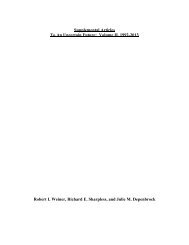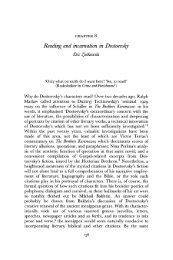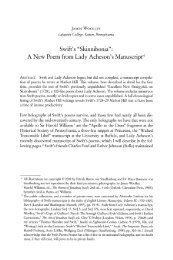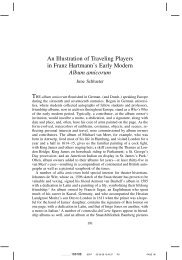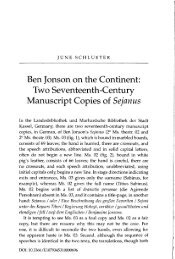courses of instruction - Lafayette College
courses of instruction - Lafayette College
courses of instruction - Lafayette College
Create successful ePaper yourself
Turn your PDF publications into a flip-book with our unique Google optimized e-Paper software.
382. Cooperative Education. Course cred<br />
it is based upon a written report and oral<br />
presentation describing a project under<br />
taken during an <strong>of</strong>f-campus scientific lab<br />
oratory experience covering a period <strong>of</strong> at<br />
least one semester and one summer. Pre<br />
requisite: permission <strong>of</strong> the department.<br />
Offered as needed. Staff<br />
391-394. Independent Study. A research<br />
project carried out under the guidance <strong>of</strong> a<br />
faculty member. May not be equivalent in<br />
scope or duration to an Honors Thesis. 391<br />
<strong>of</strong>fered in fall semester; 392, spring semes<br />
ter; 393, fall semester; 394, spring semes<br />
ter. Staff<br />
431. Advanced Inorganic Chemistry.<br />
This course uses molecular orbital theory<br />
to explain the electronic structure and re<br />
activity <strong>of</strong> inorganic complexes. Topics in<br />
clude symmetry and its applications to<br />
bonding and spectroscopy, electronic spec-<br />
troscopy <strong>of</strong> transition-metal complexes,<br />
mechanisms <strong>of</strong> substitution and redox<br />
processes, organometallic and bioinorgan-<br />
ic chemistry. Prerequisites: Chemistry 213,<br />
311, or 324, 325 or 325, 326. Mathematics<br />
162. Offered in fall semester. Mr. Barber.<br />
440. Structure Determination by Physi<br />
cal Methods. Use <strong>of</strong> infrared, ultraviolet,<br />
nuclear magnetic resonance, mass spec-<br />
trometry, and computational methods in<br />
the determination <strong>of</strong> the structures <strong>of</strong> or<br />
ganic molecules. These methods also have<br />
application to the problems <strong>of</strong> inorganic<br />
chemistry. Prerequisite: Chemistry 311, or<br />
323,324 or 325,326. Lecture/laboratory.<br />
Mr. Miles<br />
452. Topics in Advanced Biochemistry.<br />
This course covers a variety <strong>of</strong> topics with<br />
emphasis on the molecular basis <strong>of</strong> human<br />
disease, new areas <strong>of</strong> biochemical re<br />
search, and advances in biotechnology.<br />
Topics may include immunobiochemistry,<br />
molecular mechanisms <strong>of</strong> cellular signal<br />
transduction, advanced topics in metabo<br />
lism, chemical carcinogenesis, and the<br />
physical basis <strong>of</strong> biochemical methodolo<br />
gy. Prerequisite: Chemistry 351. Lecture.<br />
Offered in spring semester. Mr. Husk<br />
CHEMISTRY<br />
462. Advanced Physical Chemistry. A<br />
study <strong>of</strong> one or more selected topics <strong>of</strong><br />
current interest in physical chemistry. De<br />
pendent upon staff, topics may include<br />
advanced spectroscopy, computational<br />
chemistry, materials chemistry, or statisti<br />
cal thermodynamics. The topics and pre<br />
requisites (Chemistry 323 or 324 depend<br />
ing on topics, or permission <strong>of</strong> instructor)<br />
for a given semester will be announced<br />
before registration. Lecture. Mr. Hang,<br />
Ms. Walters<br />
470-480. Special Topics. Dependent upon<br />
staff and student interest, one or more<br />
special topics in chemistry are examined.<br />
Staff<br />
495, 496. Thesis. A student may register<br />
for this course after meeting with depart<br />
ment staff and finding a faculty member<br />
who agrees to act as his or her research<br />
adviser. Discussion <strong>of</strong> research areas with<br />
the faculty and preliminary work involv<br />
ing literature searching and planning<br />
should be completed before the beginning<br />
<strong>of</strong> the senior year. Research in some areas<br />
requires certain prerequisite <strong>courses</strong>. 495<br />
<strong>of</strong>fered in fall semester; 496 <strong>of</strong>fered in<br />
spring semester. S taff<br />
COMPUTER SCIENCE<br />
Associate Pr<strong>of</strong>essor Collins, Head; Pr<strong>of</strong>essor<br />
Schwar; Assistant Pr<strong>of</strong>essors Bjorling-Sachs,<br />
Liew<br />
Computer science is the study <strong>of</strong> algo<br />
rithms and their implementations. This<br />
field <strong>of</strong> study is quite recent more than<br />
95 percent <strong>of</strong> all computer scientists who<br />
ever lived are still alive. Its growth has<br />
been explosive, especially in subfields<br />
such as networks, artificial intelligence,<br />
and e-commerce.<br />
The main emphasis <strong>of</strong> the curricula is<br />
s<strong>of</strong>tware engineering: a systematic ap<br />
proach to the development <strong>of</strong> medium-to-<br />
large programs. One aspect <strong>of</strong> this ap<br />
proach is the separation <strong>of</strong> principles from<br />
technology. Students learn underlying<br />
concepts in lecture sections and learn tech<br />
nical details such as programming lan-



